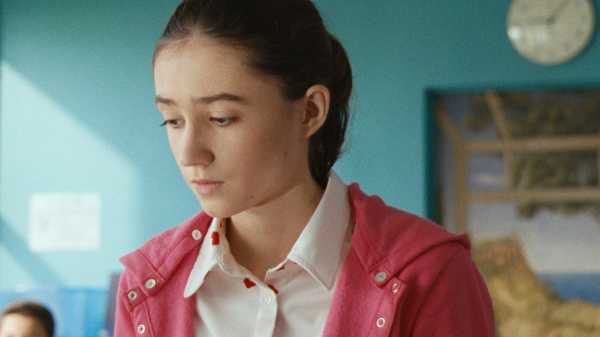
Cinematic realism is at its best when it’s dialectical—when seemingly transparent representations of dramatic action are heightened, tweaked, transformed to call attention to their styles, their methods, and their artifices. Far from submerging emotions in gamesmanship, such transformations can distill them to a concentrated intensity. That’s what the French director Axelle Ropert does in her latest feature, “Petite Solange” (opening Friday), a familiar story that she endows with overwhelming power by paradoxical means.
Its eponymous protagonist, Solange Maserati (played by Jade Springer, in her first feature), is a thirteen-year-old middle-school student in the western French port city of Nantes. She’s a bright, earnest, and outgoing child—her attentiveness and alertness show in her expressions. But something has happened to distract and perturb her, and much of the action takes place as a flashback, showing what brought her to such a state of quiet crisis. Solange is a child of the French middle-class art-ocracy: her mother, Aurélia (Léa Drucker), is a leading actress with a local theatre company who specializes in literary repertory (such as Brecht and Marivaux); her father, Antoine (played by Philippe Katerine, who’s also a well-known singer-songwriter), owns a musical-instrument shop; and her older brother, Romain (Grégoire Montana-Haroche), a twenty-one-year-old math student, is Solange’s doting confidant. The Maserati family (Antoine is of Italian descent) lives in a small, neat house on a tranquil alley, and Solange attends a calm and orderly school, where she has an unexceptional social life: a best friend named Lili (Marthe Léon), a budding crush on a long-haired boy who plays the piano (Léo Ferreira).
The heady and forward-looking serenity is too good to last. The protective cocoon of the Maserati household is rent by an argument between Solange’s parents, late at night, which she hears only vaguely, through closed doors, while discerning their bitter fury. Later, her father says that he and her mother aren’t getting along, but assures Solange that it’s normal in any marriage and that the troubles will soon pass. In a scene that echoes a similar one in Truffaut’s “The 400 Blows,” Solange espies Aurélia talking in the street with a handsome man—and then, on a visit to Antoine’s store, discovers that the real cause of marital trouble is his intimate relationship with his assistant, Gina (Chloé Astor). As Solange’s suspicions of her parents’ discord mount (Antoine sleeps in the living room; at dinnertime, Aurélia stays alone in the bedroom), she loses her focus, her composure, and her discipline—she’s distracted from her studies, she gets in trouble in school, she acts out in town. Then, to make matters worse, Romain, who has been planning to study in Madrid, can’t endure the discord and departs precipitously for Spain, leaving Solange dreadfully alone.
It’s a pleasure to recall and recount the mere plot of “Petite Solange,” because Ropert (who also wrote the script) constructs it with strong bonds of logic and fine-grained perceptions; the action advances in broad strokes, which are brought to life by a virtual filigree of carefully staged and sharply perceived details. The key perceiver, however, is Solange herself. It’s in the scenes and the images centered on Solange’s powers of outward perception and inward discernment that Ropert’s—and Springer’s—artistry bursts to the fore. The movie is filled with assertive yet graceful action that resembles a fluid choreography of daily life, but the dramatic anchor of these vigorous scenes—and the movie’s crucial trope—is stillness, the steady and seemingly frozen focus of Solange’s gaze. Solange is overwhelmed by a flood of emotions that she doesn’t yet have the resources to process, and Ropert fuses Springer’s mentally dynamic projection of this inner torrent with a repertoire of images that shudder with its invisible power. The movie is filled with shots of Solange, stopped still and staring ahead; though Ropert often makes clear what the character is seeing (Gina, in the shop, wearing Antoine’s sweater; a napkin ring with Romain’s name engraved on it), it’s the gaze rather than its target that dominates the movie. In one of the most striking moments, she observes her father and Gina through the store window, in which her own face is chillingly reflected. In a scene of the character walking disconsolately in one of Nantes’s main attractions, the ornate nineteenth-century arcade Passage Pommeraye, Ropert crafts one of the film’s most stunning images: a long zoom to spotlight Solange standing pensively still amid the crowd.
This is Ropert’s fourth feature, but the first to be released commercially in the U.S. (The other three are also screening at BAM, in a retrospective of her films; I’d especially recommend “Miss and the Doctors,” which most closely shares the aesthetic sophistication of “Petite Solange.”) I saw “Petite Solange” when it screened last March at Lincoln Center, in the annual Rendez-Vous with French Cinema, and, at the time, was struck by the movie’s silences: the largely off-mike specifics of Aurélia and Antoine’s arguments, as seen from a distance or noted behind closed doors; the parents’ withholding of crucial information from Solange until it yields faits accomplis; the silence into which the shocked and isolated girl is thrust; and, above all, in the film’s most extraordinary and disturbing sequence, Solange’s desperate, speechless nighttime ramble through the city, a scene that plays like a passionate aria minus words. On second viewing, silence and stillness are one in Solange’s gaze; if these recurring images dominate this time around, it’s perhaps because the first-time shock of the operatic sequence and its terrifying implications fits more clearly into the over-all inner disarray that Solange endures, and which Ropert depicts with a restrained and elliptical precision that renders it all the more tragic.
The movie’s dramatic stakes are enormous, ranging far beyond the breakdown of a marriage to involve the loss of Solange’s very identity. The recovery of her identity—or, rather, her effort to build one of her own, apart from the one that’s constructed around her family—is the film’s moral crux. What keeps this story’s incremental development from appearing merely informational, what gives the movie an experiential power that overrides mere messaging, is Ropert’s aesthetic originality. Her art of countermeasures, ellipses, condensations—the conjuring of furious mental action within the static moments of tumultuous drama—turns a classical setup into an exemplary modernist melodrama. ♦
Sourse: newyorker.com






